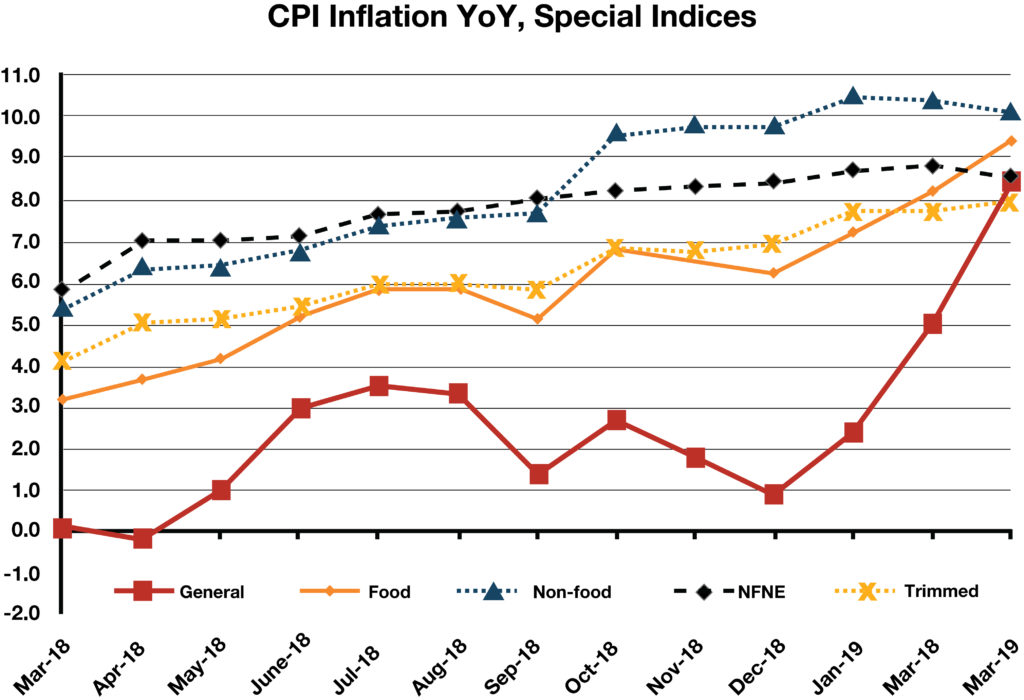You can also download an e-reader friendly version here.
The patient is headed back to the emergency room. For those that have kept an eye on the economy’s vitals, the recent spate of bad news does not come as a surprise. With a 0.5% hike in the policy interest rate, the State Bank of Pakistan is acknowledging the key dimensions of the economic challenge faced by the country:
- a stubbornly high current account deficit;
- a fiscal deficit that is growing instead of declining; and
- a rate of inflation that is the highest in over four years[i].
With the Consumer Price Index (CPI) inflation jumping to 9.4% in March (year-on-year increase), the average citizen will find it harder to maintain their standard of living and struggle to make ends meet. As usual, for Pakistan’s elite, the sun will continue to shine[ii].
| Index | March over March % Change | ||
| 2019 | 2018 | 2017 | |
| CPI | 9.42 | 3.25 | 4.94 |
| SPI | 8.81 | -1.82 | 3.12 |

The Crisis Continues
To be clear: the country’s economic woes are not an indictment of the current government or even governments that preceded it. The economic shambles are an indictment of the state and the ruling elite, which has successfully extracted rents while hollowing out the economy for at least three decades. During this period Pakistan has fallen behind its peer group of economies and the South Asian region in terms of productivity, in terms of exports, and in terms of tax growth. These three—productivity, exports and tax growth—represent the fundamental pillars without which a low-income economy cannot to transition to middle-income status.
However, it would be unfair to ignore the newly-elected government’s role in exacerbating the scope of the recent woes: after more than six months in power, there seems to be a lack of direction and focus in terms of what this government wants to achieve on the economic front. The argument that is often given by the current leadership is that it only learnt of the true extent of the economic issues after coming to power and thus needs more time. Yet this government also claims to have reformist credentials. The hopes of millions of Pakistanis that a “Naya Pakistan” will arise, bringing an era of economic and social prosperity rested largely on the preparation of this government to deliver reform—especially in the economic and financial sector. Shadow work on critical portfolios like economic affairs and finance should have started well before elections with an in-depth understanding of the chronic issues plaguing Pakistan’s economy.
Of even more concern is that a government that rose to power on the promise of real change and reform has so far relied on the old playbook of wrapping tax cuts for the elite and well-heeled as a “package of reforms”. The very same political leaders that sneered at tax amnesties for non-tax payers are now presenting similar amnesties as a solution to the fiscal crisis. The two mini-budgets presented by this government, while hailed by the lobbies that benefited from them as “reforms”, largely represent handouts to those that do not need them.
Where Do We Go From Here?
There is a saying that one should not let a crisis go to waste, and the PTI government has an opportunity to make the most of the recent economic crisis. To do so, the government must set three key principles: focus on select three to four key areas of reforms; set egos aside to engage across the aisle; and communicate to the people that decades’ worth of damage cannot be repaired during a five-year term.
As far as the first principle goes, the government, particularly the Prime Minister, need to stay focused and set realistic goals. Key reforms that need to be addressed by this government are:
- circular debt in the energy markets;
- tax reforms in the property sector; and
- skill-building across the country.
Note that these are discrete and measurable goals, not pie-in-the-sky aspirations.
In terms of the energy sector, the goal should be to erase the circular debt over five years and develop an energy sector that is governed by an empowered regulator. This should not be done by simply raising tariffs and extracting more payments from those who already pay their bills. The energy sector must be set free from the grip of vested interests, both business and political. This would free up significant government resources that are currently wasted on propping up a sector where theft, inefficiencies, and graft cost the public exchequer hundreds of billions a year. With circular debt reaching PKR 1.4 trillion, the government has no option but to borrow more in an attempt to ease the burden on electricity producers[iii]. However, this must be followed by bold reforms that have been shunned by previous governments.
The old playbook of generating revenues in Pakistan has relied on extracting every single penny from average citizens through a regressive taxation system. This policy has been so effective that tough decisions that target the elites, most of whom avoid paying their fair share of taxes and find ways to park their ill-gotten wealth in the property market, are non-existent. The journey to develop a more equal taxation system must begin by having a system that targets the property market where parked wealth is not used for productive purposes. The revenues generated from this should be distributed between local districts that collect the taxes and the federal government. This formula will ensure that a significant part of the revenues collected are invested directly into local development projects, thereby incentivizing local administrators to pursue tax collection measures.
Finally, a country where the rate of literacy stands at a meagre 58% and where workers are not equipped with the skills necessary to compete with the rest of the world cannot move forward[iv]. To deal with this crisis, the government must execute a national skill-building program on a war-footing. Without these skills, Pakistan cannot sustainably become competitive with the rest of the world, and its productive sectors will continue to lag over time. Companies and investors in the industrial and manufacturing sector should be given incentives to play a role in this program, as they are the ones who know the skills they need and are best-equipped to train human resources.
These reform measures will be resisted by the elite who have captured political parties and wield significant influence in Pakistan’s political economy. The only way to win this fight is to build consensus across the aisle. No political party in Pakistan is free from influence by powerful lobbies, and every political party has people who want to break free from their influence. Empowering these voices in all political parties will require the country’s current leadership to reach out across the aisle and seek to build consensus with people they may not like.
Finally, the ruling party (PTI) must be disciplined in how it frames its strategic narrative:
- focus on the issues at hand;
- communicate the targets that they have set for the next five years; and
- inform the public that this is a national-security crisis caused by and facing the state.
Without such clarity, the government’s efforts to tackle the roots of the economic crisis will not have the broad-based public consensus they need to successfully complete a multi-year reforms agenda.
Throwing Out The Old Playbook
Vested interests and powerful lobbies are surely going to continue engaging the government for “packages” that have never been, and will never be helpful in rescuing the economy—though they will certainly help keep these powerful lobbies very wealthy. The most recent packages given to the export sector and their failure to compete with regional players like Bangladesh and Vietnam, months after Bangladeshi labor costs increased by almost fifty percent are clear proof of the power of rent-seekers in the economy[v]. In fact, Pakistan is perhaps the only economy in the region where such incentives are handed out without so much as a discussion on expected targets, both in terms of growth and job generation. This must end, and a new policy of incentives must rely on providing incentives only after clear and measurable goals are set. Many argue that Pakistan’s economy is like a patient suffering from cancer or heart disease. A more accurate analogy is that Pakistan’s economy is like a diabetes patient: suffering from high glucose levels every few years. It never hesitates going to the doctor to get shots of insulin, but it does not change the bad habits that cause frequent trips to the hospital in the first place. The disease continues to affect organs – one after another. The patient cannot afford these continuous procedures, but it has patrons who want to prevent a complete collapse. These patrons step in to stabilize vitals and restore bodily order. And so the cycle continues. One can only hope that the PTI will put an end to this cycle and set Pakistan’s economy on the right track.
End notes
[i] State Bank of Pakistan, Monetary Policy Statement March 2019 http://www.sbp.org.pk/press/2019/Pr-29-Mar-19.pdf
[ii] Pakistan Bureau of Statistic, Monthly Review on Price Index March 2019 http://www.pbs.gov.pk/sites/default/files//price_statistics/monthly_price_indices/2019/Monthly%20Review%20March%2C%20%202019.pdf
[iii] https://www.dawn.com/news/1464127
[iv] https://tribune.com.pk/story/1419396/economic-survey-literacy-rate-pakistan-slips-2/
[v] https://www.reuters.com/article/us-bangladesh-garments/bangladesh-raises-wages-for-garment-workers-idUSKCN1LT2UR
Disclaimer: The views and opinions expressed in this article are those of the authors and do not necessarily reflect the official policy or position of Tabadlab Pvt. Ltd
Director South Asia at Albright Stonebridge Group, where he advises clients on investment and growth opportunities in South Asia.





